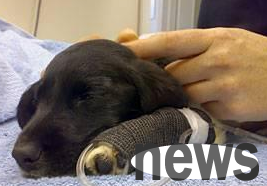Herniation of the disc or herniation of the disc into the spinal canal can lead to the most common neurological syndrome in dogs. This disease is especially common in dogs with cartilage nutrition disorders, and is clinically manifested as spinal co...
Herniation of the disc or herniation of the disc into the spinal canal can lead to the most common neurological syndrome in dogs. This disease is especially common in dogs with cartilage nutrition disorders, and is clinically manifested as spinal cord-related pain, ataxia, local paralysis, and even paralysis or spinal cord softening.

【Basic Information】
Gene: Motor system disease
Symptoms: Meningeal inflammation, nerve root compression, back pain and paralysis.
【Cause】
The cause of intervertebral disc degeneration is not yet known. As we age, the stainability of the Sinenic-O dye in the center of the intervertebral disc-nucleus pulposus region becomes obvious, and the proteoglycan content on the surface decreases. The outer layer of the intervertebral disc, i.e. the annulus, has cracks or clefts through which the nucleus pulposus protrudes toward the surroundings. Age causes the nucleus pulposus to penetrate into the spinal canal and compress the spinal cord.
【Main Symptoms】
Herniation of the intervertebral disc often occurs on the lateral, posterior and ventral sides. Occasionally, lateral herniation can cause clinical symptoms, but most dorsal disc herniation can lead to obvious clinical symptoms, manifested as meningeal inflammation and compression of the nerve root or spinal cord. Common clinical symptoms include back pain, inability to initiate, paralysis, and upper motor neuron syndrome. Lower motor neuron disease can lead to bladder relaxation and urinary incontinence.

【Diagnostic Criteria】
can make a diagnosis through medical history and clinical examination. Neurological and imaging examinations can locate the injured area. Results Imaging examinations included intervertebral space and articular surface stenosis, compression, collapse, foramen stenosis and intra-spinal calcification. Myelography is required when judging spinal cord injuries, especially multiple injuries.
【Treatment】
Conservative treatment relies on compulsive animals to rest to relieve inflammation and stabilize the herniated discs through fibrosis. Measures include limiting animal activity, reducing animal weight, and using painkillers and other medications with caution. While restricting animal activities, anti-inflammatory and muscle relaxation drugs can also be used with caution. Excessive exercise leads to worsening clinical symptoms, which are commonly found in dogs treated with medication only.